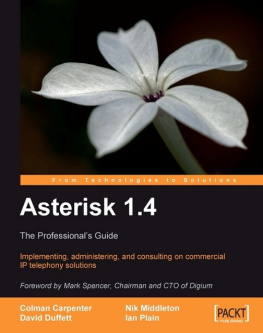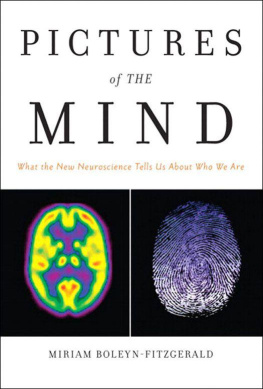Boleyn-Fitzgerald - Pictures of the mind what the new neuroscience tells us about who we are. - Description based on print version record
Here you can read online Boleyn-Fitzgerald - Pictures of the mind what the new neuroscience tells us about who we are. - Description based on print version record full text of the book (entire story) in english for free. Download pdf and epub, get meaning, cover and reviews about this ebook. City: Upper Saddle River;NJ, year: 2010, publisher: FT Press, genre: Religion. Description of the work, (preface) as well as reviews are available. Best literature library LitArk.com created for fans of good reading and offers a wide selection of genres:
Romance novel
Science fiction
Adventure
Detective
Science
History
Home and family
Prose
Art
Politics
Computer
Non-fiction
Religion
Business
Children
Humor
Choose a favorite category and find really read worthwhile books. Enjoy immersion in the world of imagination, feel the emotions of the characters or learn something new for yourself, make an fascinating discovery.

- Book:Pictures of the mind what the new neuroscience tells us about who we are. - Description based on print version record
- Author:
- Publisher:FT Press
- Genre:
- Year:2010
- City:Upper Saddle River;NJ
- Rating:4 / 5
- Favourites:Add to favourites
- Your mark:
- 80
- 1
- 2
- 3
- 4
- 5
Pictures of the mind what the new neuroscience tells us about who we are. - Description based on print version record: summary, description and annotation
We offer to read an annotation, description, summary or preface (depends on what the author of the book "Pictures of the mind what the new neuroscience tells us about who we are. - Description based on print version record" wrote himself). If you haven't found the necessary information about the book — write in the comments, we will try to find it.
Boleyn-Fitzgerald: author's other books
Who wrote Pictures of the mind what the new neuroscience tells us about who we are. - Description based on print version record? Find out the surname, the name of the author of the book and a list of all author's works by series.
Pictures of the mind what the new neuroscience tells us about who we are. - Description based on print version record — read online for free the complete book (whole text) full work
Below is the text of the book, divided by pages. System saving the place of the last page read, allows you to conveniently read the book "Pictures of the mind what the new neuroscience tells us about who we are. - Description based on print version record" online for free, without having to search again every time where you left off. Put a bookmark, and you can go to the page where you finished reading at any time.
Font size:
Interval:
Bookmark:
Pictures of the Mind is an extraordinary book. It makes the unfolding scientific story of consciousness vivid, even joyous, while offering a sophisticated tour of what is known about ourselves, our emotions, and our brains. A beautiful read.
Ruth R. Faden,
Philip Franklin Wagley Professor of Biomedical Ethics and
Director of the Berman Institute of Bioethics at Johns Hopkins University
This book explores the many ways in which neuroscience is revealing remarkable things about the inner workings of our mindsnot the least of which is the transformative impact that meditation can have on destructive thoughts and behavior. I have no doubt that Miriam Boleyn-Fitzgeralds work will be of great benefit to those with an interest in this fascinating new area of inquiry.
Yongey Mingyur Rinpoche,
Author of The Joy of Living: Unlocking the Secret and Science of Happiness
The mind is embodied, and it is relational. In this straightforward and illuminating book, Miriam Boleyn-Fitzgerald reveals pictures in both visual and narrative form that capture the power of the mind to transform the brain. How our mental lives shape and are shaped by neural circuitryitself forever being molded by experienceis the central theme of these powerful portraits of what it means to be human. By learning to focus our minds in more compassionate waystoward ourselves and otherswe can literally promote a healthier and more integrated brain. Read these pages, and youll be able to see for yourself!
Daniel J. Siegel, M.D.,
Author of Mindsight: The New Science of Personal Transformation,
Clinical Professor of Psychiatry at the UCLA School of Medicine,
Co-Investigator at the Center for Culture, Brain, and Development, and
Co-Director of the Mindful Awareness Research Center
Miriam Boleyn-Fitzgerald has given us a remarkably clear and engaging account of the ways that the new brain imaging technologies can give us deep insights into our gravest maladies. Her conclusion, that healing may often lie with us, joins science with the wisdom of the ages.
Jonathan D. Moreno,
Author of Mind Wars, David and Lyn Silfen University Professor, and
Professor of Medical Ethics and of History and
Sociology of Science at the University of Pennsylvania
An engaging and compelling read that illustrates how the new brain science can help us understand elements of our basic humanity.
Zindel Segal,
Author of The Mindful Way through Depression and
Cameron Wilson Chair in Depression Studies at the University of Toronto
and the Centre for Addiction and Mental Health
What the New Neuroscience Tells Us About Who We Are
Miriam Boleyn-Fitzgerald
Vice President, Publisher: Tim Moore
Associate Publisher and Director of Marketing: Amy Neidlinger
Editorial Assistant: Pamela Boland
Development Editor: Kirk Jensen
Operations Manager: Gina Kanouse
Senior Marketing Manager: Julie Phifer
Publicity Manager: Laura Czaja
Assistant Marketing Manager: Megan Colvin
Cover Designer: Stauber Design Studio
Managing Editor: Kristy Hart
Project Editor: Jovana San Nicolas-Shirley
Copy Editor: Deadline Driven Publishing
Proofreader: Seth Kerney
Senior Indexer: Cheryl Lenser
Compositor: Jake McFarland
Manufacturing Buyer: Dan Uhrig
Cover image courtesy of Steven Laureys, from S. Laureys, The Neural Correlates of (Un)awareness: Lessons from the Vegetative State, Trends in Cognitive Sciences 9, no. 12 (December 2005): 556-559, http://www.sciencedirect.com/science/journal/13646613.
Copyright 2005, reprinted with permission from Elsevier.
2010 by Pearson Education, Inc.
Publishing as FT Press
Upper Saddle River, New Jersey 07458
FT Press offers excellent discounts on this book when ordered in quantity for bulk purchases or special sales. For more information, please contact U.S. Corporate and Government Sales, 1-800-382-3419, .
Company and product names mentioned herein are the trademarks or registered trademarks of their respective owners.
All rights reserved. No part of this book may be reproduced, in any form or by any means, without permission in writing from the publisher.
Printed in the United States of America
First Printing January 2010
ISBN-10: 0-13-715516-6
ISBN-13: 978-0-13-715516-3
Pearson Education Ltd.
Pearson Education Australia PTY, Ltd.
Pearson Education Singapore, Pte. Ltd.
Pearson Education North Asia, Ltd.
Pearson Education Canada, Ltd.
Pearson Educacin de Mexico, S.A. de C.V.
Pearson EducationJapan
Pearson Education Malaysia, Pte. Ltd.
Library of Congress Cataloging-in-Publication Data
Boleyn-Fitzgerald, Miriam.
Pictures of the mind : what the new neuroscience tells us about who we are / Miriam
Boleyn-Fitzgerald.
p. cm.
ISBN-13: 978-0-13-715516-3 (hardback : alk. paper)
ISBN-10: 0-13-715516-6 (hardback : alk. paper) 1. Neurosciences. 2. Brain--Psychophysiology.
I. Title.
RC341.B65 2010
616.8--dc22
2009040031
In memory of my brother Steven.
Imagine your mind is a yard on a clear March day. Youve been offered a chance to walk around. You may choose to clear fresh paths through the brown winter muck, pick up bits of trash you forgot were buried under all that ice and snow, decide what new seeds to plant and where. Youve been told your soil is richmuch richer than you thoughtand now you are sure that with time and attention and a lot of gritty work, you can grow almost anything. You roll up your sleeves and take stock. What habits of mind will you dig up and toss on the compost heap? What mental skills and emotional states, what beliefs about yourself and the world will you choose to cultivate?
Little more than a decade ago, the physical landscape of our minds was perfectly invisible to us and, for all we knew, as fertile and productive as it was ever going to get. Even if we were aware of our thoughts, ideas, and emotions, we had no way of watching the neural activity associated with mental phenomena arise, do its thing inside our heads, and pass away. We had no way of watching that activity actually alter and strengthen our neural networks. Now, thanks to powerful new imaging tools like functional MRI (fMRI) and positron emission tomography (PET), we can watch the organ of the mind in action, and what we see is exhilarating: The brain has the capacity to heal, grow, and change itself in ways that before were thought impossible.
Conventional scientific wisdom used to paint a starkly different picture of the adult brain, one in which its physical structure was essentially immutable. By the age of three, the story went, most neural networks were in place, and by late adolescence, our temperamentour baseline chemical state of happiness or irritabilitywas thought to be fixed. If we had always been a sunny kid, our outlook would probably tend toward the golden for the rest of our lives, but for those of us born and raised on the dark side of the moon, we would probably always struggle with negative emotions like anxiety, sadness, and aggression. Compounding the depressing picture was the conviction that, were we to lose nerve cells through disease, aging, or injury, there was very little point in ever wishing them back.
Now we can watch our brains on-screen, healing and adapting to challenges, and we see that our genes and early experiences absolutely do influence our cognitive and emotional makeup in important ways, and that they absolutely dont get to dictate who we become. This previously unappreciated flexibility and trainability of neural pathways is termed neuroplasticity, and it has transformed modern neuroscience into an intensely optimistic field where researchers seek new diagnostic techniques and therapies for patients recovering from structural damage and chemical imbalances due to traumatic brain injury, stroke, Alzheimers disease, emotional disorders, drug addiction, and chronic pain. Research into neuroplasticity isnt just revealing how we can heal brain injuries and sharpen our wits, but also how we can strengthen key neural pathways to become happier, kinder, less fearful, and more effectual merely by changing the way we perceive the world and our reactions to it.
Font size:
Interval:
Bookmark:
Similar books «Pictures of the mind what the new neuroscience tells us about who we are. - Description based on print version record»
Look at similar books to Pictures of the mind what the new neuroscience tells us about who we are. - Description based on print version record. We have selected literature similar in name and meaning in the hope of providing readers with more options to find new, interesting, not yet read works.
Discussion, reviews of the book Pictures of the mind what the new neuroscience tells us about who we are. - Description based on print version record and just readers' own opinions. Leave your comments, write what you think about the work, its meaning or the main characters. Specify what exactly you liked and what you didn't like, and why you think so.










